Konaseema is a delta located in the East Godavari and West Godavari districts of Andhra Pradesh, India. This delta is surrounded on all sides by waters (of Godavari and the Bay of Bengal). Konaseema is famous for its scenic greenery and vedic scholars. The origin of the name may be from Telugu word "Kona" meaning corner which resembles its shape. The northern side is bounded by Gautami Godavari and southern side is bounded by Vasista Godavari. It is one of most fertile lands present in Coromandel Coast. The entire region is rich in Coconut trees, Mango grooves, numerous canals, backwaters, Temples and Traditions. Coconut palms, the arboreal symbol of Konaseema landscape, fringe the backwaters framing the blue tropical sky during daytime and a starry twinkling firmament during evenings. There are diverse sceneries along the backwaters crisscrossing the coastal areas. The culture of konaseema is rich traditional culture of Andhra. The festivals of Rathotsavam (for Lord Vishnu) and Prabhala Teertham (for Lord Shiva) are famous all through the region. Most famous of Rathotsavam festivals are of Antarvedi teertham and Yanam teertham. Most famous of Prabhala Teertham are Jaggannathota teertham and Chintalooru teertham. The major towns which constitute Konaseema are Amalapuram, Ravulapalem, Razole, Amlapuram: Amala-puram is a town in East Godavari district in the state of Andhra Pradesh, India.It is the headquarters of Godavari delta named Konaseema, the triangle formed by the Holy waters of Godavari. These lands (Black cotton soil) are highly fertile for growing coconut tree and rice crops. Kakinada and Rajahmundry are the two connecting cites to Amalapuram. Lots of fish varieties available here. There are the famous temples of Lord Venkateswara, Lord Subrahmanyeswara and Lord Chandramouliswara located in this town. This town is known for its Vedic culture and its development. Every nature lover's dream come true, Amalapuram is blessed with lush fields, coconut groves, green palms and is criss - crossed by small canals. This picturesque village 65 Km from Kakinada via Yanam, offers easy access to other places of tourist interest such as Vigneswara temple at Ainavilli, Vireswara temple at Muramalla, Uma Koppulingeswara Swamy temple at Palivela, Sri Skhana Mukteswara Swami temple at Mukteswaram, Allavaram beach etc. Ravula-palem is a town in East Godavari district, Andhra Pradesh state, India. It is located near the Godavari River. It's well known as The Gateway Of Konaseema. Food: Vindu restaurant is famous Dhaba in Ravulapalem. Razole is a village and mandal in East Godavari district of Andhra Pradesh, India. One find innumerable canals, Coconut grooves and backwaters while visiting this district. The coconut county resorts are close to Rajole. Konaseema Temples: Holy Temples & religious shrines have always been a strong reason of travel in Andhra. There are many temples in Andhra with excellent architecture and a story behind each temple. If you go and visit these temples in India, you will feel so holistic and create an unmemorable experience. We offer temple tours and arrange packages covering all important temples in and around Konaseema and Godavari districts. The important temples of Godavari district are Vinayaka temple at Ainavilli, Sri Jagan Mohini Keshava Swamy at Ryali, Sree veereswara swamy temple at Marumalla, Sri Someswara Swamy Temple at kotipalli , Sri Suryanarayana Swamy Varu at G mammidada, Bheemeshwara Swamy at Draksharamam, Sri Kukkuteshwara Swamy Temple at pithapuram, KUMARA RAMA AT SAMALKOTA, Sri Lakshmi Narasimha Swamy Temple at anthervedi, Venketeshwara swamt at appanpalli, Sri Kshira Rama Lingeshwara swamy at pallakollu, Sri Someshwara Janardhana swamy at Bhimavaram. Other Important temples in east Godavari are Annavaram, Biccavolu , Thalupulamma Talli – Lova etc. The best part is while visiting these temples you would get an opportunity to experience the tradition of art, culture and lifestyles of Rural Andhra. You can enjoy a blend of rural and Temple Tourism Please check the Piligramage tabs for detailed information on each temple. Konaseema Rural Tourism: India is a country of rich culture and heritage. With above 70% population residing in around 6 million plus villages, real India has its roots right inside this simplistic structure. With Rural Tourism, we try to take you to a journey of not so known( places like Konaseema, ) – the land and people which is the back bone of this country. It is a journey to explore diversity and hospitality from nook and corners of Rural India. Here is an attempt from vizag Tourism to take you away to Konaseema , a dream land full of peace, simplicity and innocence. Connect with nature, unlearn luxury, and spend time looking at surroundings and people who support your life by providing the raw inputs for complex city life needs. What you explore during these tours is a unique experience and an eye opener to the basics of a developing economy. For corporate people, this gives a day off to go back to roots and this gives an opportunity to spend time in the rural atmosphere away from the Mouse and the motherboard. The different villages that you visit as a part of Konaseema package are sure to leave lasting memories in your mind. This is an opportunity to see the India described in novels for people engaged in hustle and bustle of daily city life. The best part is while visiting these places you would get an opportunity to experience the tradition of art, culture and lifestyles of Rural Andhra. You can enjoy a blend of rural and Temple Tourism as you would get a chance to visit various temples in your rural tourism itinerary. There is an option to stay in a farm House equipped with all facilities to have a feel of the rural atmosphere. Back Water Tourism of Konaseema: Konaseema is known for its backwaters. They as a whole, form an intricate network of lagoons, lakes, canals, estuaries, and rivers that drain into thebay of bengal.. Boating along the backwaters offers spectacular views and vistas of konaseema’s pristine natural beauty. Coconut palms, the arboreal symbol of Konaseema landscape, fringe the backwaters framing the blue tropical sky during daytime and a starry twinkling firmament during evenings. There are diverse sceneries along the backwaters crisscrossing the coastal areas. Cruising along the backwaters is an ideal way to discover the real Konaseema. The placid backwaters that stretch for kilometers are covered with swinging, coconut trees, canals and small islands. Tourists can go ga-ga over Godavari cruise - Spend a day and night in the fully furnished cruise that will wind across the Godavari and her tributaries Vynateya and Vasishta Let vizag Tourism help you explore the unexplored beauty of Andhrapradesh. A House boat trip to Konaseema is sure to rejenuvate your mind, soul and body. and Houseboat packages which will help you explore this place. The house boat activity begins from Dindi coconut County Resorts in Rajole district.The boat cruises until Narsapur and Shivakodilanka and crosses various lagoons. Other places of Attraction in Konaseema: Adurrru Bhuddist stupas: Adurru is located on the western bank of the Vainetaya branch of Godavari river which is around 9.5 km from sea. The village is quiet close to Nagaram and is located in Mammidikuduru mandalam. and is a part of the east Razole taluk of East Godavari district, Andhra Pradesh. The place is famous for a mound which the localites call Dubaraju Gudi. Excavations carried out in the year 1953 brought to surface a mahastupa which measures 17 feet in diameter. A raised platform surrounds it all around. The excavations also revealed shreds of jars, troughs, dishes and bowls of red and kaolin. The excavation site covers an area of 2.04 acres and makes for a worthwhile visit during your Buddhist trip to Andhra Pradesh. Coringa Wild Life sanctuary: It is at a distance of about 15 Km from Kakinada on Kakinada Yanam Road. Coringa Sanctuary, named after a tiny village coringa in East Godavari District of Andhra Pradesh a part of Godavari Mangroves was declared as a wildlife sanctuary by Govt. of Andhra Pradesh vide G.O.Ms.No - 484, Forests and Rural Development (For.III) Department dated 5-7-1978 was to conserve the mangrove vegetation of the estuary, extending in an area of about 235.Sq.Kms. The best way to Enjoy coringa is by a Boat. One can also visit Mada forests. Kadiyapulanka: Kadiapulanka, about 8 Km from Rajahmundry is the hub of nurseries of myriad varieties of flowers and fruits. The nurseries in Kadiam are as old as 100 years and at present there are more than 600 nurseries, the extent of each ranging from just 0.5 cents to 200 acres. Nursery products from Kadiapaulanka are exported to every nook and corner of the country. Every year in the month of January, an annual flower show is held when one can see a wide range of nature's most beautiful creations. Yanam: This destination which is a part of Pondicherry is located in between Amlapuram and Kakinada. Yanam has got a very beautiful view. It is covered with coconut trees. One can have fresh iodinised air since it is located over the banks of the Gauthami Godavari River. Humidity is high in this region. This river Gauthami Godavari is one of the main branches of the river Godavari. It enters the Bay of Bengal after crossing around 12 km. Festivals The Venkanna Babu Festival will be celebrated in the month of March every year by the people of Yanam in very grand manner. The festival will be continued for one month. Lord Venkateswara Kalyanam is the main day of the festival. Ponnavahanam (Last Vahanam), Ratha yatra (Rathotsavam) and Chakratirtham are the important events of the festival. In these days nearly 1.5 lakhs of devotees will come to Yanam to take the grace of the Lord Venkanna Babu. History of Ratham The Ratham was built in 1950 by the then Committee under then Assemblée Répresentative, Kanakala Tatayya Naidou. The Ratham weight is around 15 tonnes. It was partially damaged to the heavy cyclone in November 1996 . It was renovated in 1998. This Ratham was carried through out entire Yanam Town in earlier days. After the electrification works, this route is limited from Chinna Center to the Kotha Bus Stand. It will be carried out by only the devotees with full of slogans, bhajans. The Govt of Pondicherry declares Holiday for on this special event. Catholic festival From then, every year in March, a major festival is being celebrated. Devotees from various neighbouring places used to come here and worship the Lord Mariamma. The very remarkable thing is that the devotees are not only from the Christians but also Muslims, Hindus and other religions. Brahmotsavam It was conducted for Lord Venkanna Babu in Yanam during September/October which resembles Tirupati Brahmotsavam. It is a 10-day festival which attracts millions of crowds from surrounding villages of Yanam. | 
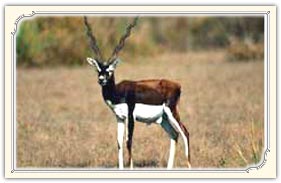 Mahavir Harina Vanasthali National Park is situated in Vanasthalipuram, which is around 15 kilometers from the city. Mahavir Harina Vanasthali Wildlife Sanctuary in Hyderabad has been named after the holy Jain saint 'Lord Mahavira'. It was established in 1975 on this renowned saint's 2500th birth anniversary. This sanctuary was once the exciting 'Shikargarh' or hunting ground of one of the Nizam rulers. It has now been converted into a protected national park under the law. The park is in full bloom during monsoons when beautiful flowers of different colors blossom all around. This Mahavir Harina Vanasthali National Park is home to the endangered Black Buck deer. An estimated 400 deer roam around the National Park fearlessly.
Mahavir Harina Vanasthali National Park is situated in Vanasthalipuram, which is around 15 kilometers from the city. Mahavir Harina Vanasthali Wildlife Sanctuary in Hyderabad has been named after the holy Jain saint 'Lord Mahavira'. It was established in 1975 on this renowned saint's 2500th birth anniversary. This sanctuary was once the exciting 'Shikargarh' or hunting ground of one of the Nizam rulers. It has now been converted into a protected national park under the law. The park is in full bloom during monsoons when beautiful flowers of different colors blossom all around. This Mahavir Harina Vanasthali National Park is home to the endangered Black Buck deer. An estimated 400 deer roam around the National Park fearlessly.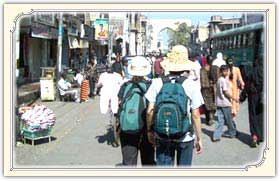 Laad Bazaar is located in Hyderabad right next to the historic Charminar. Situated on one of the four main roads that shoot out from the Charminar, it is sited in a very old area of Hyderabad, the capital of Andhra Pradesh.
Laad Bazaar is located in Hyderabad right next to the historic Charminar. Situated on one of the four main roads that shoot out from the Charminar, it is sited in a very old area of Hyderabad, the capital of Andhra Pradesh.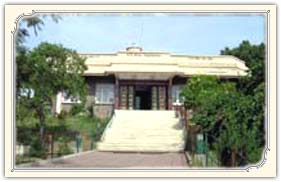 The Birla Planetarium in Hyderabad is an accolade to the advances made in technology and science since the dawn of human civilization. Late Sri N.T.Rama Rao inaugurated this beautiful dome shaped architectural wonder, on 8th September 1985. The B.M. Birla Planetarium and Science Museum is an absolute visit during your trip to Hyderabad. Kids are sure to enjoy this planetarium and the variety of knowledge it has to offer.
The Birla Planetarium in Hyderabad is an accolade to the advances made in technology and science since the dawn of human civilization. Late Sri N.T.Rama Rao inaugurated this beautiful dome shaped architectural wonder, on 8th September 1985. The B.M. Birla Planetarium and Science Museum is an absolute visit during your trip to Hyderabad. Kids are sure to enjoy this planetarium and the variety of knowledge it has to offer. 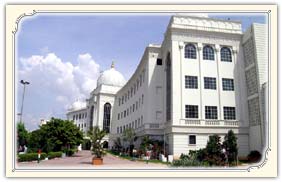 The Salar Jung museum in Hyderabad is one of the oldest museums in the city. It is the only museum that has the largest compilation of personally collected artifacts from all around the world. This museum has the greatest collection of rare antiques and knick-knacks from all over the world. One needs to devote an entire day for touring the museum itself.
The Salar Jung museum in Hyderabad is one of the oldest museums in the city. It is the only museum that has the largest compilation of personally collected artifacts from all around the world. This museum has the greatest collection of rare antiques and knick-knacks from all over the world. One needs to devote an entire day for touring the museum itself.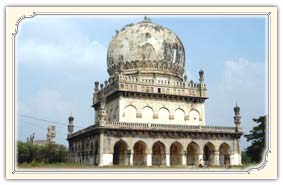 Qutub Shahi Tombs are located in the heart of the Hyderabad city. The Qutub Shahi Tombs are quite close to the Golconda Fort, which is a famous landmark of Hyderabad. The Qutub Shahi Tombs are a perfect blend of Indian and Persian architectural forms, constructed in gray granite decorated with exquisite ornamentation. The tombs are domed structures, which are built on an elevated square base surrounded by pointed arches. Each tomb is quadrangular and rises to a height of 9 - 15 meters above the terrace. The smaller tombs are single storied while the larger ones are double storied. The domes were originally covered with blue and green tiles, of which only a few pieces remain now.
Qutub Shahi Tombs are located in the heart of the Hyderabad city. The Qutub Shahi Tombs are quite close to the Golconda Fort, which is a famous landmark of Hyderabad. The Qutub Shahi Tombs are a perfect blend of Indian and Persian architectural forms, constructed in gray granite decorated with exquisite ornamentation. The tombs are domed structures, which are built on an elevated square base surrounded by pointed arches. Each tomb is quadrangular and rises to a height of 9 - 15 meters above the terrace. The smaller tombs are single storied while the larger ones are double storied. The domes were originally covered with blue and green tiles, of which only a few pieces remain now.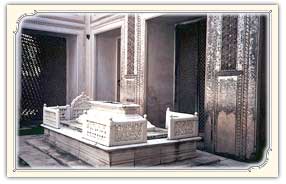 The Paigah Tombs in Hyderabad, India are the tombs of the several generations of the Paigah nobles. The Paigah nobles were very close to the Nizams and so they enjoyed a significant social status. They were given the responsibility of looking after the security and defense of the state. Some of the Paigah nobles who have been laid to rest here are Asman Jah, Viqar-ul-Umara and Shams-ul-Umara.
The Paigah Tombs in Hyderabad, India are the tombs of the several generations of the Paigah nobles. The Paigah nobles were very close to the Nizams and so they enjoyed a significant social status. They were given the responsibility of looking after the security and defense of the state. Some of the Paigah nobles who have been laid to rest here are Asman Jah, Viqar-ul-Umara and Shams-ul-Umara. 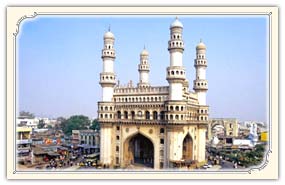 The elegant structure of the Charminar in Hyderabad is a vivid example of Cazia style of architecture comprising of granite and lime-mortar. Mohammed Quli Qutub Shah built this Islamic architectural splendor in the year 1591. Charminar is the most famous landmark of the city and most tours to Hyderabad include the Charminar as an absolute essential. It is a must see if you are visiting Hyderabad.
The elegant structure of the Charminar in Hyderabad is a vivid example of Cazia style of architecture comprising of granite and lime-mortar. Mohammed Quli Qutub Shah built this Islamic architectural splendor in the year 1591. Charminar is the most famous landmark of the city and most tours to Hyderabad include the Charminar as an absolute essential. It is a must see if you are visiting Hyderabad.



























